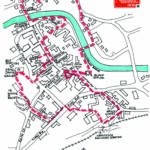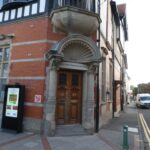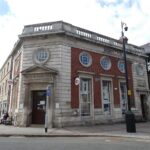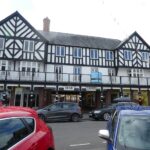Town Trail 4 Newtown Heritage Plaque Walk
This short, easy stroll around Newtown gives you an insight into the long history of a “new” town since the 13th Century. Follow the trail and take the time to be introduced to local characters such as John Roberts, the Romani Gypsy harpist who was famed as the country’s leading performer on the Welsh triple harp. Discover how King Edward 1 granted a charter to Roger Mortimer of Wigmore Castle to establish a new town in the Manor of Cedewain, Newtown, as it quickly became known. A real gem for locals and visitors alike to visit and marvel at the remains of the Motte and Bailey built in the 13th Century. Scan the QR codes on the coloured plaques with your smart phone to get more detail on the town’s famous people and places.
2.2 miles • 1.5 hours • Very Easy
Images
Directions
1
Brisco House. This building was erected as a free public library in 1903 on land gifted by Mrs Frances Arbuthnot-Brisco. The building was paid for by the Town Council and the Co-operative Union, and Brisco House is now occupied by the Town Council and the Robert Owen Museum. Across the street is
2
HSBC Bank (Birthplace of Robert Owen). Pioneer of infant education, social reforms and the co-operative movement, Robert Owen was born here at No.2 Broad Street, on the 14th of May 1771. Turn right up Broad Street and left into the covered Bear Lanes to reach
3
Bear Lanes Shop (Laura Ashley). Laura Ashley (1925 – 1985), well known for her fashion and fabrics, began her company here in Mid Wales. She had a number of factories in Newtown, and a shop on this site for many years. Return to Broad St, cross the street and go down the lane on the right next to Spar to Old Church Street to reach
4
Robert Owen’s Tomb. St Mary’s church was built in the 13th century and was Newtown’s parish church for 500 years, until frequent flooding meant it fell into disuse. The tomb of Robert Owen, the world-renowned social reformer is here, enclosed behind the commemorative railings. Go around the church to the footpath above the river. Turn left to reach the Elephant and Castle hotel. Across the street is
5
Flannel Exchange. Following the rapid rise of the handloom weaving industry in Newtown in the early nineteenth century, this building was erected in 1832 to house the local flannel market. It has also been used as a public hall, a court, a theatre, meeting hall and Post Office and is currently a cinema, bar and nightclub. Turn right across
6
Long Bridge. There was a wooden bridge here from the 14thC, replaced by this stone one in 1826. In 1857 the footpaths, supported by iron arches, were added to make the bridge safer for pedestrians. At the roundabout, turn right into Commercial Street and cross the road to the
7
Textile Museum. A former woolen factory built around 1831, which combined domestic accommodation with industrial space. There would have been perhaps some thirty people crammed into the six, one-up-one-down cottages of the two lower floors of the building, with two large loom floors above. Cross the road again and take the next right, Chapel Street and turn left on to Frankwell Street. At the end, turn right and go down the first street on the right, Golwgydre Lane, which brings you on to
8
Halfpenny Bridge. For many years a man known as Tommy King collected a toll of a halfpenny from those wishing to cross over this footbridge. Thus the bridge acquired the name “Halfpenny” or “King’s Bridge”. It was swept away by floods several times, and the present single span Halfpenny Bridge was built in 1972. Cross the footbridge and turn left along the footpath above the river. At the junction of the paths go ahead down the grassy bank to
9
Black poplar. Find out about this rare tree on the information board in front of the tree. Facing the tree turn left, past the public toilets and turn right up Shortbridge Street, passing the statue to Robert Owen on your right, cross the street to Market Street to reach
10
The Horse Market.This was the part of the town where horses were sold, as there were fields here allowing prospective buyers to try them out. The area called the Horse Market extended from the far end of Market Street to where the Post Office now is. Go down the lane on the left, turn left and right back into Shortbridge Street, continue past the Post Office and cross New Road at the lights. Continue ahead up Old Kerry Road to the warehouses of
11
Pryce Jones.Pryce Jones was born in Llanllwchaiarn, Newtown in 1834, and was the pioneer of the first international mail order business selling flannel from this building, the Royal Welsh Warehouse. He also invented the sleeping bag! His loyal and royal customers included Queen Victoria. Bear right past the building and cross the street to
12
Newtown Railway station (David Davies). David Davies (1818-1890) was responsible for laying 145 miles of railway tracks in Wales, including opening a rail link between Newtown and Llanidloes in 1859. He was a Member of Parliament, owned coal mines in the Rhondda valleys and is regarded as Wales’ first millionaire tycoon. Facing away from the station cross the road and follow the lane past the Phoenix Community Furniture store and enter the churchyard of St David’s church. Cross the church grounds and come out on to New Road. Cross the road, turn left and take the first right to
13
Frolic Street. John Roberts, the Romani Gypsy harpist was born in 1816. He was famed as the country’s leading performer on the Welsh triple harp. In 1850, with his wife and nine children, he moved into a tiny house here in Frolic Street. Go along Frolic Street, cross Park Street and up the bank in the park which is part of
14
Motte & Bailey. In the 13th century King Edward I granted a charter to Roger Mortimer to establish a new town, thus the, actually very old, town of Newtown was formed. This mound or “motte” was built to provide the usual fortified protection of the mediaeval town and a timber keep was probably built on it. Follow around to the right of the mound and cross the grassed area to
15
Oriel Davies Gallery. Oriel Davies Gallery is a public art gallery of Wales, presenting world-class, thought-provoking and challenging art by national and international artists. The Gallery and exhibition spaces are free, family-friendly, physically accessible and ideal for experiencing contemporary art. Turn slightly left on leaving the gallery, exit the park through the wrought iron gates, cross the road, Back Lane, and continue ahead on the right side of Broad Street to
16
The Market Hall. The market hall was built by Wastel Brisco, who owned the local Newtown Hall, and opened on Tuesday 20th December 1870. It was well used for many years including by the military in the Second World War, and was only recently renovated to its original condition. Cross Broad Street to
17
WH Smith. In the 1970’s a major modernisation programme of WH Smith’s outlets was in progress. It was decided that just one shop should be conserved. The Newtown branch had not been altered very much over the years, so the shop was restored to as it would have been when first opened in 1927. Continue along Broad Street to High Street at the Cross and
18
Town clock. The Cross Buildings were erected in 1897 and stand at the end of the High Street link at its junction with Broad Street, Severn Street and Shortbridge Street. It is a striking Victorian brick edifice with some intricate details in stone, the Clock Tower is perhaps the most well-known landmark in Newtown.
* Please note that the plaques located at 2, 3 and 12 were awaiting installation.
More Walks

 Download Walk
Download Walk



